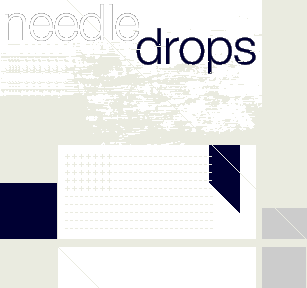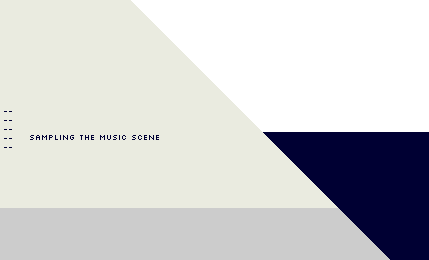


++ Contact Philip Sherburne ++
++ Recently ++
Tuesday, November 29, 2005 = The Stooges Unearthed (Again)
Tuesday, November 8, 2005 = Documenting Beulah And DCFC
Tuesday, November 1, 2005 = Out-Of-Control Rock 'N' Roll Is Alive And Well
Tuesday, October 25, 2005 = Just In Time For Halloween
Monday, October 3, 2005 = The Dandyesque Raunch Of Louis XI
Monday, August 15, 2005 = The Empire Blues
Tuesday, August 9, 2005 = David Howie's Sónar Diary
Monday, July 25, 2005 = Hot Sounds For Summertime
Monday, June 27, 2005 = Overcoming Writer's Block At Sónar 2005
Monday, June 4, 2005 = Cool New Sounds To Download Or Stream
++ Needle Drops Archives ++
View full list of Needle Drops articles...
|
|
 |
January 4, 2002
++ Winter Drones
I'm a sucker for a drone. Some of the greatest rock 'n' roll owes its
spirit to the drone: just think of the Velvet Underground's "Sister
Ray," or the monochrome arrow that pierces every one of My Bloody
Valentine's songs. But recently it's electronic music, with its
attention to texture and tone color, that has made the most of drone
music's pure sonority. That was the project of early ambient, of
course, and in the mid-'90s, "isolationist" artists risked frostbite
to seek out ever more forbidding corners of sound.
Today, dark ambient music is more advanced than ever, thanks in part
to increasingly sophisticated-yet-affordable technologies, but also
to the commitment of artists across a broad spectrum seeking to mold
sound like a solid object (let's not forget that "stereo" comes from
the Greek word for "solid"). In the winter months, I tend to seek out
the darkest, heaviest blocks of sound I can find, and I leave the
best discs playing in the CD changer as I drift off to sleep. I'm not
looking to be soothed — it's about sound as a blanket, a weight
so heavy you can feel it pressing upon you, so black it makes mirages
in the unfathomable distance. These four recent discs all take the
measure of sound's specific gravity and come up with radically
different results.
++Thomas Köner, Daikan (Mille Plateaux)
Thomas Köner has
never been about warm fuzzies. As half of Porter Ricks, he drove dub
techno into ever-colder climes, and his solo work takes ambient
isolationism to the darkest, iciest reaches of sound. His first
release for Mille Plateaux since 1998's brilliant Kaamos,
Daikan was recorded live in Montreal, where it won the
Performance prize at FCMM 2000. The recording presents a single,
hour-long composition, almost entirely shorn of melodic movement.
Instead, a fuzzed drone circles high overhead, changing in color as
it catches the frozen light. Occasionally, a new tone appears on the
horizon and the astral symphony's balance shifts ever so slightly, as
though the weight of the world itself had changed. At times the hum
recedes to the faintest whisper, and you're left craning your neck,
trying to catch the fading trace of the incursion.
++ Kontakt der Jünglinge (Thomas Köner + Asmus
Tietchens), 0 (Die
Stadt)
In this follow-up to the duo's 1999 recording, 1, Köner
and Tietchens present a live performance from October 2001. Over the
course of 40 minutes, waves of static lap at the speakers and a
buried energy wends its way through the murk. At times the circling
airplane of Köner's Daikan seems to make an appearance;
other times, what sound like field recordings of water and wind
sketch out an empty sonic wilderness. Twenty-five minutes in, blunt
bass stabs chop at the air, suggesting the collision of nature and
technology. In the end, though, this is a piece less to be theorized
or analogized than simply experienced with closed eyes and wide-open
ears: an experience of pure being-in-sound.
++ Francisco López + Joe Colley, Knowing When Not to
Know (Antifrost)
Spain's Francisco
López is best known for his early work exploring the
limits of perception and the grey area between audibility and
silence. Of late, though, he's climbed the wall of sound to gain a
better vantage point over a sprawling landscape of full-spectrum
noise, both on his solo CDs (such as the sublime Untitled #104
for Alien8) and in collaboration with Zbigniew Karkowski, John
Duncan, Amy Denio and others. On this 3" CD, Sacramento's Joe Colley
contributes to an 18-minute piece that crawls out of silence to
ascend to a buzzing, dizzying peak before it quickly fades back into
nothingness. At its high point, a squall of white noise is rent by
arrows of feedback and threaded with ribbons of glistening tone,
until the air around you feels as though it bristled with light. Five
minutes before it ends, silence imposes a curfew, but a rebel faction
breaks loose, brandishing rattling percussion and snatches of radio
fuzz in a soft cacophony of bebop, lounge music and Hawaiian guitar,
and the anonymous revelers carouse their way through the darkness
— until they're shot dead with the abrupt end of the CD.
++ A.F.R.I Studios, Goodbye If You Call That Gone (Lucky Kitchen)
This makes the third and final release from Andrés Franz
Krause under the A.F.R.I. Studios alias. While he's not a household
name by any stretch of the imagination, Krause's work is slowly
coming into a wider audience, many of whom have recently been
enraptured by the organic electronics of the Softl Music label, which Krause
runs alongside Tom Records' Tom
Steinle.
At times it doesn't seem as if anything is even happening on this
album, but damned if it isn't one of the most powerful ambient
recordings of 2001, the audio equivalent of light scraping across the
mottled surface of water. The first track, nine minutes long, simply
revolves in empty space, a single low tone paired with a single high
tone in such a way that the harmonics kaleidoscope into a dizzying
array of frequencies. The second track fleshes out that pattern,
adding a dissonant hint of melody and vague percussive scrapings in
the distance — but even so, over the course of its seven
minutes, there's barely any movement. On the final track, a resonant
mass is wrapped in long sheets of throb and hum, where dissonant
wrinkles snap open into bleach-white octaves: 13 minutes of
illuminated bliss.
|
| |
|